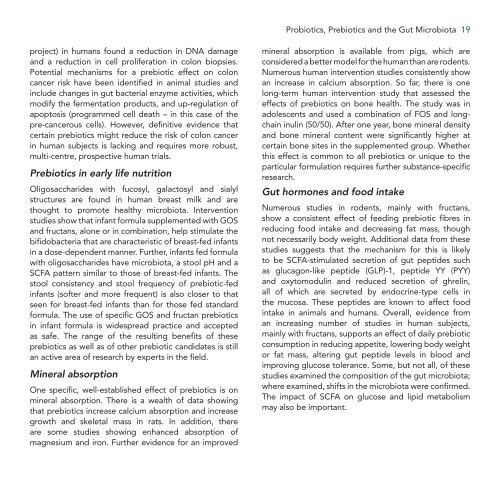probiotics, prebiotics and the gut microbiota - International Life ...
probiotics, prebiotics and the gut microbiota - International Life ...
probiotics, prebiotics and the gut microbiota - International Life ...
Create successful ePaper yourself
Turn your PDF publications into a flip-book with our unique Google optimized e-Paper software.
Probiotics, Prebiotics <strong>and</strong> <strong>the</strong> Gut Microbiota 19project) in humans found a reduction in DNA damage<strong>and</strong> a reduction in cell proliferation in colon biopsies.Potential mechanisms for a prebiotic effect on coloncancer risk have been identified in animal studies <strong>and</strong>include changes in <strong>gut</strong> bacterial enzyme activities, whichmodify <strong>the</strong> fermentation products, <strong>and</strong> up-regulation ofapoptosis (programmed cell death – in this case of <strong>the</strong>pre-cancerous cells). However, definitive evidence thatcertain <strong>prebiotics</strong> might reduce <strong>the</strong> risk of colon cancerin human subjects is lacking <strong>and</strong> requires more robust,multi-centre, prospective human trials.Prebiotics in early life nutritionOligosaccharides with fucosyl, galactosyl <strong>and</strong> sialylstructures are found in human breast milk <strong>and</strong> arethought to promote healthy <strong>microbiota</strong>. Interventionstudies show that infant formula supplemented with GOS<strong>and</strong> fructans, alone or in combination, help stimulate <strong>the</strong>bifidobacteria that are characteristic of breast-fed infantsin a dose-dependent manner. Fur<strong>the</strong>r, infants fed formulawith oligosaccharides have <strong>microbiota</strong>, a stool pH <strong>and</strong> aSCFA pattern similar to those of breast-fed infants. Thestool consistency <strong>and</strong> stool frequency of prebiotic-fedinfants (softer <strong>and</strong> more frequent) is also closer to thatseen for breast-fed infants than for those fed st<strong>and</strong>ardformula. The use of specific GOS <strong>and</strong> fructan <strong>prebiotics</strong>in infant formula is widespread practice <strong>and</strong> acceptedas safe. The range of <strong>the</strong> resulting benefits of <strong>the</strong>se<strong>prebiotics</strong> as well as of o<strong>the</strong>r prebiotic c<strong>and</strong>idates is stillan active area of research by experts in <strong>the</strong> field.Mineral absorptionOne specific, well-established effect of <strong>prebiotics</strong> is onmineral absorption. There is a wealth of data showingthat <strong>prebiotics</strong> increase calcium absorption <strong>and</strong> increasegrowth <strong>and</strong> skeletal mass in rats. In addition, <strong>the</strong>reare some studies showing enhanced absorption ofmagnesium <strong>and</strong> iron. Fur<strong>the</strong>r evidence for an improvedmineral absorption is available from pigs, which areconsidered a better model for <strong>the</strong> human than are rodents.Numerous human intervention studies consistently showan increase in calcium absorption. So far, <strong>the</strong>re is onelong-term human intervention study that assessed <strong>the</strong>effects of <strong>prebiotics</strong> on bone health. The study was inadolescents <strong>and</strong> used a combination of FOS <strong>and</strong> longchaininulin (50/50). After one year, bone mineral density<strong>and</strong> bone mineral content were significantly higher atcertain bone sites in <strong>the</strong> supplemented group. Whe<strong>the</strong>rthis effect is common to all <strong>prebiotics</strong> or unique to <strong>the</strong>particular formulation requires fur<strong>the</strong>r substance-specificresearch.Gut hormones <strong>and</strong> food intakeNumerous studies in rodents, mainly with fructans,show a consistent effect of feeding prebiotic fibres inreducing food intake <strong>and</strong> decreasing fat mass, thoughnot necessarily body weight. Additional data from <strong>the</strong>sestudies suggests that <strong>the</strong> mechanism for this is likelyto be SCFA-stimulated secretion of <strong>gut</strong> peptides suchas glucagon-like peptide (GLP)-1, peptide YY (PYY)<strong>and</strong> oxytomodulin <strong>and</strong> reduced secretion of ghrelin,all of which are secreted by endocrine-type cells in<strong>the</strong> mucosa. These peptides are known to affect foodintake in animals <strong>and</strong> humans. Overall, evidence froman increasing number of studies in human subjects,mainly with fructans, supports an effect of daily prebioticconsumption in reducing appetite, lowering body weightor fat mass, altering <strong>gut</strong> peptide levels in blood <strong>and</strong>improving glucose tolerance. Some, but not all, of <strong>the</strong>sestudies examined <strong>the</strong> composition of <strong>the</strong> <strong>gut</strong> <strong>microbiota</strong>;where examined, shifts in <strong>the</strong> <strong>microbiota</strong> were confirmed.The impact of SCFA on glucose <strong>and</strong> lipid metabolismmay also be important.
















